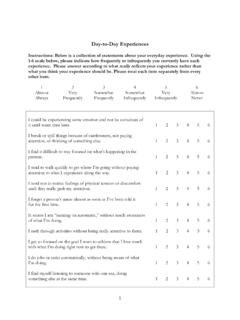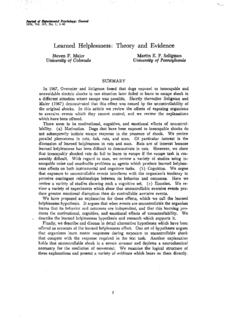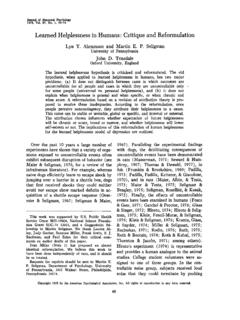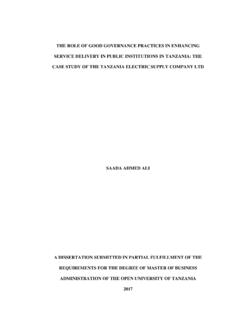Transcription of PERMA and the building blocks of well-being
1 Full Terms & Conditions of access and use can be found Journal of Positive PsychologyDedicated to furthering research and promoting good practiceISSN: 1743-9760 (Print) 1743-9779 (Online) Journal homepage: and the building blocks of well-beingMartin SeligmanTo cite this article: Martin seligman (2018): PERMA and the building blocks of well-being , TheJournal of Positive Psychology, DOI: link to this article: online: 16 Feb your article to this journal Article views: 407 View related articles View Crossmark dataThe Journal of PosiTive Psychology, 2018 and the building blocks of well-beingMartin SeligmanPsychology, university of Pennsylvania, Philadelphia, Pa, usaABSTRACTS eligman (2011) hypothesized that PERMA (Positive Emotion, Engagement, Relationships, Meaning, and Accomplishment) are the elements of well-being .
2 Goodman, Disabato, Kashdan & Kaufmann (2017) reported strong evidence that subjective well-being is the final common path of such elements and their data are entirely consistent with seligman s hypothesis. They argued, incorrectly however, that he suggested that PERMA constituted a different kind of well-being rather than just its building blocks . The complicated issue, one that transcends psychometrics, of how to decide on elements of well-being is 2011, I suggested that PERMA (Positive Emotion, Engagement, Relationships, Meaning and Accomplishment) are five measurable elements that make up well-being ( seligman , 2011, pp 16 25). Goodman, Disabato, Kashdan, and Kauffman (2017) measured PERMA and subjective well-being (SWB) for 517 Mturk ers.
3 For measures they used the PERMA -profiler (Butler & Kern, 2016), and they combined three scales, Satisfaction with Life (Diener, Emmons, Larsen, & Griffin, 1985), plus a single item happiness measure, and a three item negative emo-tion scale to form the SWB variable. The PERMA -profiler includes the three negative emotion items and one overall satisfaction with life is what they found: First a latent correlation of .98 between the PERMA -profiler and SWB. This convinces me that SWB probably is the useful final common path of the elements of well-being . I had not made my mind up about this until I saw the .98 correlation, and I had previously worried that there might be no single indicator of overall well-being (Forgeard, Jayawickreme, Kern, and seligman (2011).)
4 Having a single indicator which is a good first approximation of well-being is a boon for measurement and this confirms Layard s (2006) theory that well-being simply amounts to , Goodman et al. (2017) found that each of the elements of PERMA correlated moderately highly (range .37 to .79, mean = .61) with each other. They concluded from these two findings: that PERMA does not yield a new type of well-being , and PERMA does not offer any insights beyond SWB. In a related polemic Kashdan (2017) argued that PERMA is redundant with I claimed that PERMA constitutes the elements of well-being , not that it forms a new kind of well-being , I find their data completely consistent and confirming of the claim that PERMA constitutes (at least some of ) the elements of well-being .
5 Their conclusion that PERMA is redundant with SWB and theoretically arbitrary is, I believe, that we are interested in the psychometrics of baseball pitching. We measure 517 fans overall subjective ratings of pitching excellence for pitchers. Someone pro-poses that pitching is made of three elements: the fast ball, the curve ball, and the knuckle ball. So we also measure the fans subjective ratings of these three elements of pitching as well. We find that the overall goodness of pitching rating correlates .98 with a statistically fancy combination of the ratings of each of the three proposed elements. Further we also find that the three elements correlate about .61 with each should we conclude? First that the theory of the elements was correct and these three pitches are three of the elements of pitching.
6 Secondly that pitchers who pitch one element tend to pitch all three elements at roughly the same level of rated this reason the Goodman et al. (2017) data exactly confirm that PERMA constitutes (at least some of the) ele-ments of well-being and that people who have one of the elements tend roughly to have the other elements to a similar do I find their conclusion that PERMA is therefore redundant incorrect? Because building happiness is not primarily a psychometric issue, even though measuring 2018 informa uK limited, trading as Taylor & francis groupKEYWORDSWell-being; measurement; PERMA ; sWBARTICLE HISTORY received 6 January 2018 accepted 15 January 2018 CONTACT Martin seligman M. seligman (4) The elements lead to specific interventions to build each element and SWB ( PERMA meets this modestly).
7 (5) The list is parsimonious (five does rather better than 196).6) Each element can be defined and measured inde-pendently of the other last criterion requires discussion. Each element of PERMA can be defined independently of the others and each can be measured independently. So far so good. But the measures are not remotely orthogonal, since the meas-urement of each element correlates strongly, although imperfectly, with the measurement of each other. Does non-orthogonality disqualify elements?Let s look more deeply. One possibility is that each ele-ment is in reality the same thing as each other and as SWB and that would indeed render them redundant, disquali-fying them as elements of SWB. But there are other more likely explanations for the strong cross-correlations.
8 In the Goodman et al. (2017) study, the measures are self-reports by MTurkers, and there is likely a halo effect that inflates each cross-correlation, their common method variance. Even deflating for the halo to find the true underlying cross-correlations, there are likely causal connections and third variable connections among the elements, people who find their work meaningful likely accomplish more and people who had a warm childhood likely have better relations and more positive emotions. But such connections among the elements do not disqualify them as elements. A strong throwing arm, for example, would produce a robust cross-correlation between the fast ball and the curve decision about useful elements of SWB should take reality, as well as the psychometrics of self-reported measures, into account.
9 Good relationships, meaning and accomplishment are not after all exhaustively measured by self-report. We also want to know how your husband rates your marriage, how your bosses and employees rate your self-reported accomplishment, and how others rate the amount of meaning in your life. We also want to know about the relationships of the elements longitudi-nally, not just cross-sectionally. Might PERMA predict SWB later over and above SWB now? Supplementing self-re-ports with more objective measures would likely drive down the cross-correlations. Further the effectiveness of interventions primarily directed toward single elements should inform the usefulness of the proposed elements (McQuaid & Kern, 2017): does building patience, for exam-ple, increase engagement, without much influencing meaning?
10 At present little is known about which inter-ventions impact which elements of PERMA the most and which interventions merely impact global SWB. Finally we happiness is (in large part) a psychometric issue. Let s say I am a pitching coach and I only take the overall rating of goodness of pitching seriously, disregarding the elements of pitching because they correlate perfectly with the over-all rating. What do I tell my pitchers to do? Pitch well! Not very useful. But taking the elements seriously, in contrast, tells me to work on the curve ball, and the fast ball, and the knuckle ball, and even which pitch to concentrate on someone who works on interventions to build hap-piness, what should I do if I were to take seriously the con-clusion that PERMA is redundant, or indiscriminable from, SWB.










